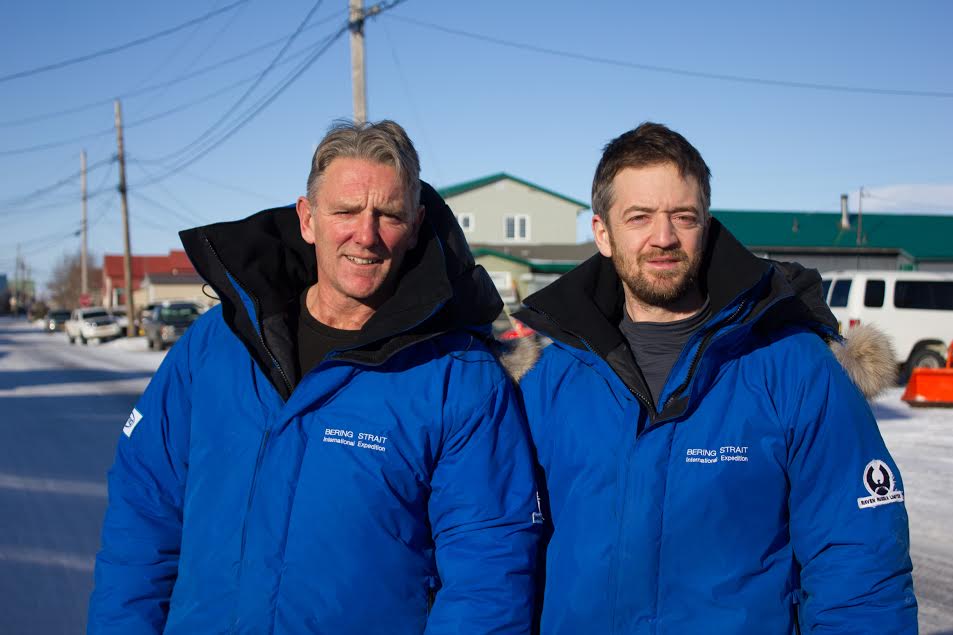Two British explorers were rescued from the icy waters of Bering Strait yesterday afternoon. Neil Laughton and James Bingham left the village of Wales on the western edge of the Seward Peninsula on Wednesday. The men were attempting to cross the strait when they began to drift north into open ocean.

Laughton andBingham started their journey on foot from the village of Wales Wednesday morning. They planned to walk over ice and paddle in open water in the hopes of reaching the island of Little Diomede. Bingham says they fell victim to changing ice conditions in the Bering Strait.
“The issue we face now with global warming is that the ice just isn’t forming,” said Bingham. “It makes what was already a challenging expedition close to impossible.”
They knew they needed to be prepared for open water since Bingham made a similar attempt just last year. He was deterred by the inconsistent ice conditions. This and last year’s attempts are practice. The two are training to cross the entire Bering Strait in 2017.
Neil Laughton says things started to go wrong by the end of their first day.
“We’d been paddling quite hard for nine or ten hours. We’d got approximately halfway across the Strait,” Laughton explained.
That’s when he said they noticed ice forming around their kayaks.
“We were having to punch through with the paddles to break the ice to make progress,” Laughton said. It was very hard, very slow, and quite debilitating.”
Near nightfall, they couldn’t continue paddling because of thin ice. And they couldn’t pitch a tent due to the lack of thick ice. Instead they pulled their kayaks up onto the slushy ice and hunkered down.
“We spent the night in the open in our clothing, kind of involuntarily shivering for the next twelve hours until daybreak,” described Laughton.
By the time the two woke up, the ice had frozen around. Bingham said it started to carry them even farther north into open ocean.
“So there really was no way out of it,” Bingham explained. “We were caught in this ice drifting north, further and further away from our objective.”
It was at that point that Bingham and Laughton decided to call for help. They both say they would have kept going if the ice were thicker. Laughton said that it still wasn’t solid enough to walk across.
“As soon as you stepped off onto this ice there were parts where it would hold you for a bit, and then suddenly your feet would go through and you’d fall in,” Laughton said.
“So it was just a pretty dire situation. You couldn’t paddle, you couldn’t walk. Check. Check Mate,” Laughton admitted
“We were in Kodiak getting ready for a training flight and the SAR alarm went off.” Explained U.S. Coast Guard Lieutenant Andrew Jarolimek. Air Station Kodiak was contacted for the search and rescue mission Thursday morning. They sent a C-130 aircraft and two Jayhawk helicopters.
Laughton and Bingham were spotted from the C-130 drifting on a section of sea ice about 25 nautical miles northwest of Wales. Jarolimek, who was piloting one of the Jayhawks, lowered a rescue swimmer down onto the ice.
“He was able to give him a general assessment and they were cold, but in good spirits, and happy to be rescued,” Jarolimek explained.
Jarolimek said they were actually well prepared for the expedition, but the drifting sea ice worked against the two explorers. Laughton and Bingham were flown back to Nome yesterday afternoon. Laughton says they escaped mostly unscathed.
“James has a little frostbite on his fingers. Me, being a bit older and uglier and harder skinned, I’m fine, thanks,” Laughton joked.
Both Laughton and Bingham seem to be aware of the risks associated with their Bering Strait expedition.
“We kind of estimate there are three outcomes on this project: there’s success, there’s rescue, and there’s death,” Laughton explained. “When success starts to fade away, you’re left with two, and that’s the reason why we pulled the pin early.”
Laughton, who has summitted Mt. Everest five times and skied to both the North and South Poles, says the Bering Strait crossing is at the top of his list. But ice conditions in the strait are now so unpredictable that a crossing of this kind be nearing impossible in the years to come.
Emily Russell is the voice of Alaska morning news as Alaska Public Media’s Morning News Host and Producer.
Originally from the Adirondacks in upstate New York, Emily moved to Alaska in 2012. She skied her way through three winters in Fairbanks, earning her Master’s degree in Northern Studies from UAF.
Emily’s career in radio started in Nome in 2015, reporting for KNOM on everything from subsistence whale harvests to housing shortages in Native villages. She then worked for KCAW in Sitka, finally seeing what all the fuss with Southeast, Alaska was all about.
Back on the road system, Emily is looking forward to driving her Subaru around the region to hike, hunt, fish and pick as many berries as possible. When she’s not talking into the mic in the morning, Emily can be found reporting from the peaks above Anchorage to the rivers around Southcentral.




